| |
| |
Working on a Madonna world tour is not
an easy task but the man we meet today had the chance to
work "almost" on all of them.
The MadonnaTribe team has had an interesting chat with Peter
Morse, the lighting director of Madonna's Who's
That Girl, Blond Ambition, Girlie
Show and Drowned World tours,
who will be taking our readers behind the scenes of the
creative process of those tours with charming anecdotes
and amazing photos from his private collection, and exclusively
reveals why he didn't do the first and latest Madonna tours.
Get ready to read how "nothing makes the darkness go like
the light".
|
|
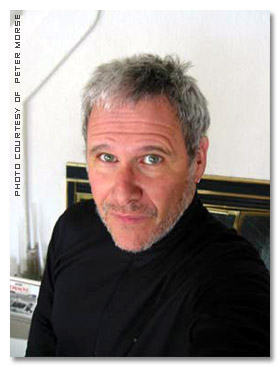 |
MadonnaTribe: Hi Peter,
welcome to MadonnaTribe and thanks for sharing this time
with us. Let's start talking about your early years. During
your high school years in Chicago you were a folk music
prodigy and you had your first album released on Philips
when you were only 16. Can we say music has been in your
life since day one?
Peter Morse: Where did you get that?
(laughs).
Yes absolutely. That was my indoctrination. I was a folk
singer back many years ago. That was my background other
than the usual sport. I started professionally in the
music field right around the age of 15.
MT: So how being a musician yourself
helped in your job as a lighting designer?
PM: Well it helps a lot, I pursued music
beyond that point when I went to college I minored in
music and I had lots of formal music training, I studied
Opera and legitimate singing.
So I learned the fine points of music but what helped
me as far as lighting is fully understanding and comprehend
the areas of the performance that are really intensified
by the music. I can focus on the music when necessary
and understand the challenge.
The real challenge came a few years ago when I had to
do Yanni. All his music is in strange music signatures
and it was easier to understand because of my musical
background. I just feel I can listen to the music and
know where the accents are. I can follow it more technically.
|
|
| |
MT:
Your first steps in the entertainment industry as a lighting
designer were with Mac Davis first, and then you worked
with Loretta Lynn and Tina Turner. How things have changed
for you since then?
PM: Considerably! Back in the
days when I first started doing lighting by today's standards
we were in the dark age. We were nowhere near the technology
we enjoy today. It was very basic, it was more theatrical
and more artistic.
There was not computerization so basically it was all hands
on.
Every fixture had to have a colour, had to have a purpose
and I learned to think ahead, "ok if I'm going to designate
certain fixtures on this show I better know what they are
going to do", because nothing changed, nothing moved,
nothing changed positions, it was all predestined.
|
|
| |
It took a lot of forethought but it was also simplier. If
I try to do today what I did then, which is basically come
in, knowing nothing and just wing it, so to speak, I wouldn't
get away with it. Today you need to be educated in the technology
of the business in order to pull it off.
MT: Can you tell
us a bit of the process behind the work of the lighting
designer? And of course, about your own way to work and
design.
PM: Well there
are several elements that come in to play.
First of all the actual phisical presentation of the set
design and what it's going to take to light the set and
the stage presented me by the stage designer and the artist.
The other element that then comes in to play of course is
the music and understanding the artist, not only the artist's
music.
Let me break it down further.
|
|
| |
First it would be understanding what's needed to ligth the
stage and the set itself.
Secondly understanding the music and getting a feel for
the music, where the nuances are, the highs and the lows
etc.
And the next step is understanding the artist, and his or
her interpretation of the music. The more important is getting
a feel and try to understand what they are saying with the
music. What part of the song is the most important to them.
The next phase is looking at the choreography if there's
any, such as in Madonna of course, and marrying those four
elements together without losing anyone of them, without
giving up on any of them, keeping in mind what needs to
be lit technically for the set, musically what's happening,
choreographicaly what's happening and most importantly what
the artist is really feeling and what the lyrics mean, melting
all that together and keep in mind all those elements.
MT: Is that also where you get your inspiration
from?
PM: Absolutely, The most
difficult shows I've ever done are those that don't have
an inspired artist or inspired music. Yes they can be lit,
but if don't get some sense of direction of emotion from
the artist that makes it more complicate. It can be done
but I think a clear understanding of the artist you're working
for is the most important thing.
|
|
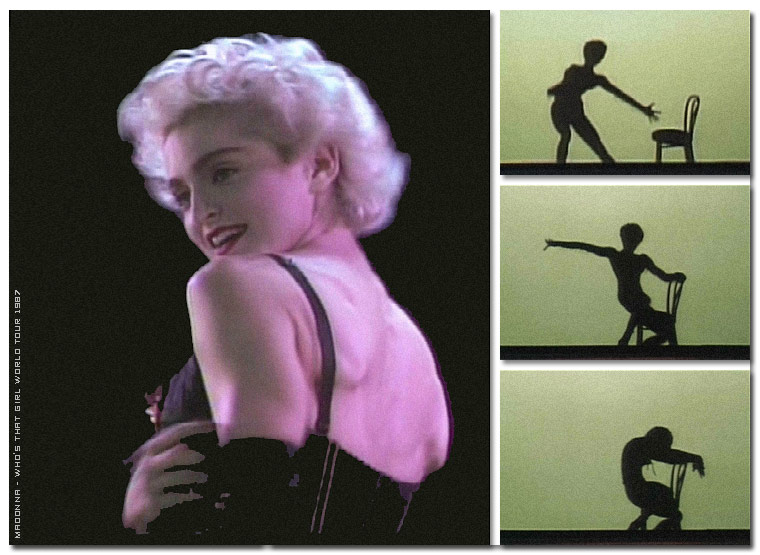 |
| |
MT: And speaking
about Madonna, do you remember the first time you met her
and you were asked to work with her? It's quite a long time
ago...
PM: Yes it was.. Interestingly (laughs)...
it's a good story. She had not done a tour yet, she had
just released her first album and she was very hot and Freddy
De Mann who was managing her at the time had seen the lighting
I had done for other artists, one in particular was Kim
Carnes who did the song "Bette Davis Eyes", and
called me into meet with her and we sat and we were talking
and her first idea was a theatre tour.
She was rather definite about what
she had in mind and I had some ideas for a set and she had
no set designer and she liked my ideas she said: "Can
you draw them for me" And I said "Well I'm not
an artist but I will go to someone and have my ideas drawn
and I'll bring them back to you".
So I did that and we sat and looked at the drawings and
it was not a particularly good day for her, she was in the
recording studio having some problems and she looked at
the drawings with me and she said: "Well but where
am I in these drawings?" And I said " well you're
here" and she said "Draw me" and I said "I'm
not an artist".
|
|
| |
She then said: "Well you've got to draw something
so I can see what you're talking about". So I drew
a rather terrible stick figure (laughs) 'cos I'm not an
artist. And she was very upset about that. And in the
end that first tour I didn't do.
She was upset with me.
Basically I was the first person ever hired and the first
person ever fired by Madonna. So I didn't do her first
tour.. what was the name?
MT: It was called "The Virgin Tour"...
PM: Yeah right "Virgin tour".
What happened really was that the drawings I presented
were based on a theatre tour and of course it was not
very long it became an arena tour.
And of course the ideas we had discussed were too small
for that. So basically I wasn't hired (laughs).
Two years lated Freddy came to me and said that they wanted
me for the "Who's That Girl" tour.
|
|
| |
I was hired and basically stayed with her ever since and
it's interesting Madonna in those days was demanding very
short on praise but heavy on ridicule so you never got much
praise from her but you definately heard from her when you
did something wrong.
And she was not very supportive but what she did have was
a very strong and amazing sense of work ethic, she worked
harder and put in more hours than anybody and I had a very
deep respect for her not only musically but for her professional
work ethic.
Personally she didn't really go out of her way to get along
with anybody she just wanted to do ne right but as the years
progressed she's matured and mellowed and become more and
more depending on and involved with the artistic people
around her. Certainly more appreciative also.
|
|
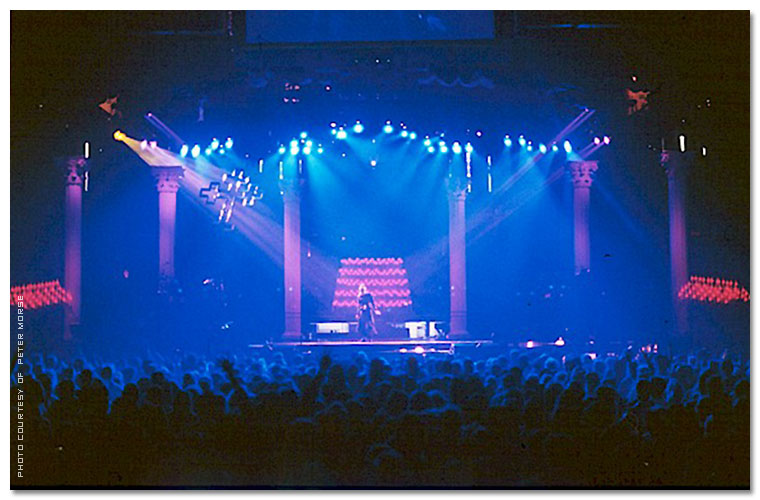 |
| |
MT: You have been working on four Madonna's
world tours. Were you expecting it to last so long? Designers,
directors, everything changed but you've been with her from
the "Who's That Girl" to the "Drowned World
Tour". Do you have a feeling of why?
PM: Yes, it is interesting because as each tour
was in the making I would get a call and it felt wonderful
because, let's face it, there's no guarantees when you're
an independent contractor, and basically she kept calling
back to do the next tour and the next tour.
The next tour which we did was the "Blond Ambition"
- I still feel it's one of the classics, one of the best.
It was a wonderful melt of music, visual and artistic, set,
everything just seemed magical in that period.
|
|
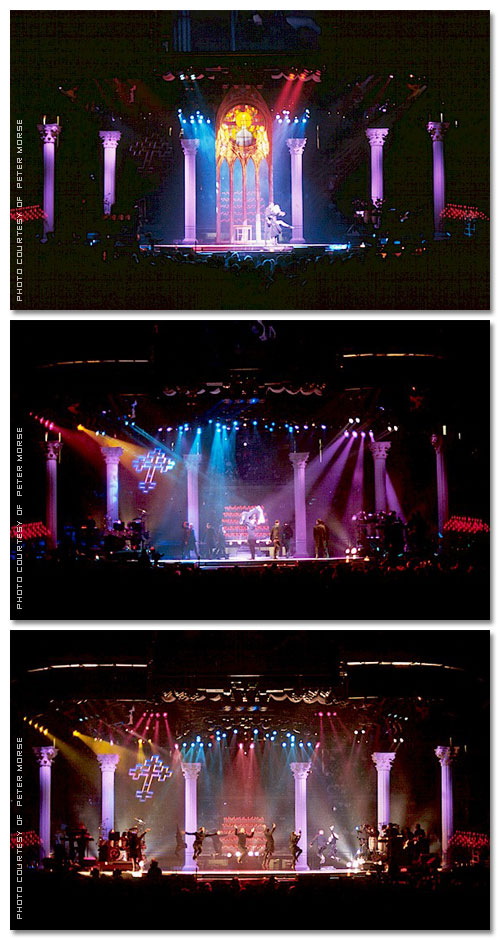
|
And about loyalty, I don't expect an artist to stay loyal.
An artist may have different needs for different types of
people, especially with Madonna as she changes and she's
so a chameleon-like. With each tour she was basically a
different personality and a different presentation on stage.
I mean we've done the same song three different ways...
MT:
Well she did "Holiday" each time.
PM: Absolutely, so each time I would think maybe
she won't want to use me on this but I would invariably
get the call and it just solidified my feeling of family
and it was more comfortable each time we did it. And it
grew to be a family because it came to be up to a certain
point where it was always the same core of people involved.
Interestingly the director changed more often than any of
us did. Jamie [King] got involved with "Drowned World
Tour" and Vince Paterson did "Blond Ambition".
And for good reasons she made changes.
She's very bright that way.
And on her latest tour, she did not use me. And for whatever
reasons I respect that. Jamie called me and said "Peter
we are making some changes" and I said "I understand"
and frankly if that had not happened I would have not been
able to do Prince, it all works out that way thank God (laughs).
But I have no loss of respect for her I feel it was a creative
decision and she has the right to make it.
MT: How much did you know of Madonna before
working with her?
PM: The very first time I knew very little.
I knew of her record and her videos, that was the boy toy
era, the movie she made "Desperately Seeking Susan".
That's all I knew of her at that time.
My first impression of her was that of somebody who had
an innate understanding of what she was doing. And she was
very different, very focused.
But I didn't quite understand her and certainly when she
got upset with me for drawing the stick figure (laughs).
Interestingly when I got called to come in for "Who's
That Girl", they had actually hired another designer
who they were not happy with and Freddy and I had actually
worked together on Lionel Ritchie at the time and he asked
me to please come and see if I could save the show or the
lighting.
So I came in and spent time with her and we bonded there.
|
|
| |
I
actually got to know her a little better and understood
her a little better. And that's what helped me immensely
for "Blond Ambition".
Interestingly on "Blond Ambition" when we were
in the planning stages, what impressed me was when she walked
into our first production meeting with me and Chris Lamb
and few others and sat down with a legal pad where she had
written in long hand the entire idea of the show and scene
by scene, and she even had sketches.
She designed and played out the show in her own mind long
before any of us got involved and the end result of "Blond
Ambition" hardly varied at all from her original concept
drawings.
And that's a great statement to her innate intelligence
and understanding of herself. We just followed her lead
on "Blond Ambition" and she took us all the way
through.
|
|
|
MT: From the point of view of the audience,
every show has some highilights, scenes or sequences that
people are impressed with and keep in their mind as a snapshot.
One of my strongest memories of the "Who's That Girl"
show was the way projections were used during the show.
PM: Originally, the gentleman that was hired brought
projections to Madonna, this was before I was involved.
The only drawback to that whole plan was the venetian blinds
type of scenary they were shooting on was susceptible to
the outdoor breezers and the wind.
That was conceived before I got involved and I think what
was happening, the lighting designer who was involved with
it was being ultra careful, very theatrical, he was very
careful not to contaminate those images, which is fine but
in the end he ended up not doing enough lighting on her
for her taste or on the stage so I came in and I had to
build up the lighting levels considerably but at the same
time in such a way not to contaminate the images.
The projection idea was so new to her that was very important
to her to keep that intact. Of course nowadays technology
has evolved in such degree that with led walls there's no
worry of that sort of things, but it was really a challenge
those days.
MT: In the "Blond Ambition" tour
a great moment is the opening act inspired by Fritz Lang's
"Metropolis". What was the idea behind the "Express
Yourself" light design?
PM: That was one of my favourite scenes.
The minute I saw the drawings and the models I knew what
I had to do with that. It was very industrial and very period
type of presentation.
"Metropolis" was a futuristic movie back in the
thirties.
I wanted to create that feel along with her and still keep
the rock feel. So we put lots of patterns in the light that
reflected the turning of the gears and made a very industrial
look on the stage around her.
|
|
| |
So we kind of split the difference between the "Metropolis"
feel of the Thirties and the feel of the Ninetes.
The set was so strong that basically just illuminating it
would have been enough but we had to surround her with that
feel and drawing some patterns on the backdrop.
It was interesting because every move she made on that show,
every entrance she made was just beautifully choreographed,
everytime she entered the stage it felt like it was the
first time we were seeing her, every entrance was equally
exciting and that's what I loved about that show.
|
|
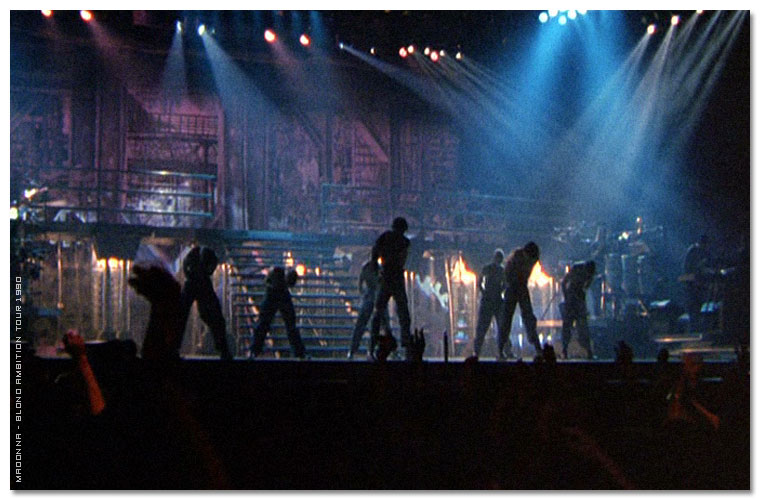 |
| |
And no two songs were alike, every song had a distinctive
look, so it was fun coming up with different lighting and
colour combinations and I must tell you she came to me then
and she did this again on "Drowned World Tour"
and told me "I don't want to see any look more than
once. Oh I saw this three songs ago".
So that's a challenge when you got two and half hours to
do. It was a great education. With any artist I feel most
excited about the work I do when I feel I'm learning something
at the same time I'm doing my craft and that was always
the case of her.
|
|
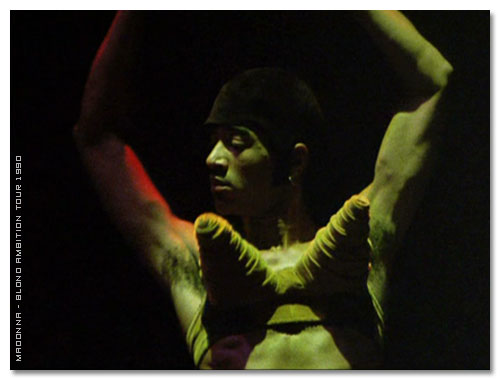 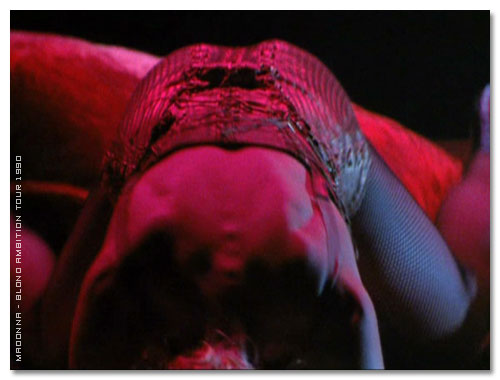 |
MT: What about the infamous "Like
A Virgin" performance. Besides the stir it may have
caused, that "bed" scene had a marvelous lighting...
PM: That was a wonderful moment. Obviously
I got the feel I was hand in hand with her with challenging
the critics. There was no question she was going to get
some challange as she did in Italy if I remember right...
MT: Yes ahaha...
PM: She was going to get challanged on
that song more than any other in her show. Infact in Canada,
in Toronto, they didn't want to let her go on unless she
took that song out of the show.
I don't remember the politics involved but I think they
agreed but when it came time to do it she did it anyhow
(laughs).
That was an incredibly simple song to light, and again the
importance of that song was really keeping it as simple
as possible and letting the performance do it all.
That song was all performance.
MT: And how was the lighting of the "Like
A prayer/Oh Father" sequence on the same tour?
That's another of the highlights of that show, was it hard
to achieve the right balance between all the different kind
of light sources you've been using in that scene?
PM: That was another favourite moment in
the show. That was Madonna's chance to be theatrical. The
choreography was extremely theatrical, very dramatic, almost
ballet and opera meeting rock and roll.
I remember one moment, the minute I saw it in rehearsals,
I knew what we had to do, it was very simple.
The music and the choreography was so perfect together I
knew immediatly what I to do. It was all there with no second
guessing.
|
|
| |
Ironically
was the most complicated number and yet it was the easiest
to put together because I knew from the beginning what we
had to do and it worked.
And it wasn't to my credit as much to the song itself, that
whole selection of songs and the choreography. It was all
there in front of me. It was real obvious what we had to
do.
That was really a joy and one of the high points of the
show. That and "Vogue"... (laughs)
|
|
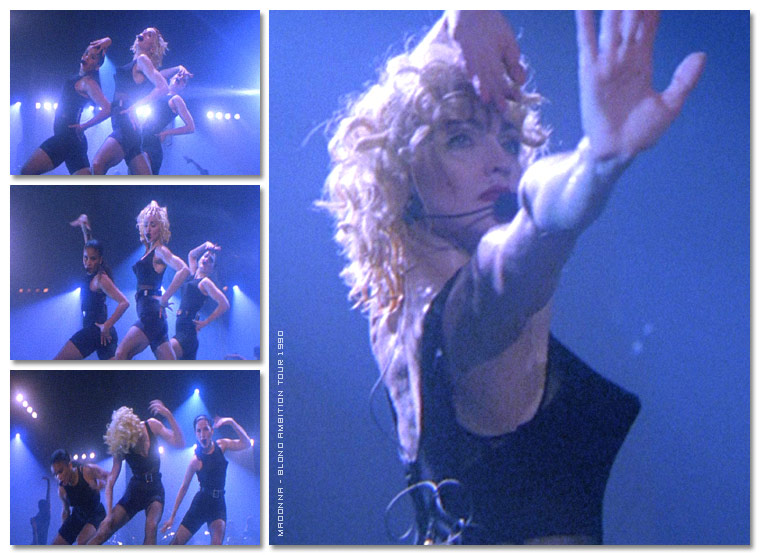 |
| |
MT: Yes, let's talk about "Vogue"...
PM: "Vogue"
was interesting because the backdrop, the influence of nudity,
that whole vogue feeling, I took my lead from there and
lit it from one direction and then another.
The choreography being as significant as it was with all
their hand motions I decided I couldn't light it straight
on and present it like a dance number but I wanted to present
it by snapshots. So
in certain moments in the music the light would come from
one direction or the other, depending where they were on
stage. So it was continual snapshots.
We hit a moment and then fade away for it and then hit another
moment and that made that number distinctive.
MT:
So you made the lights vogueing as well...
PM: Yes I wanted the light to "vogue"
along with her, that's a good point, I didn't think of it
in those terms (laughs)...
|
|
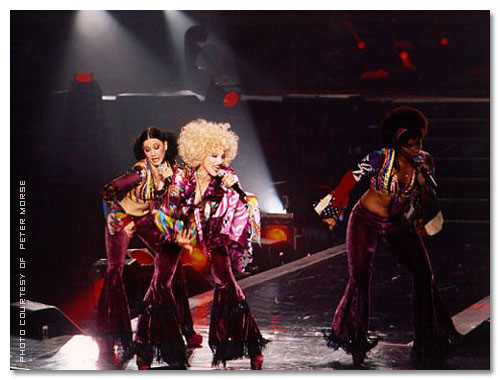
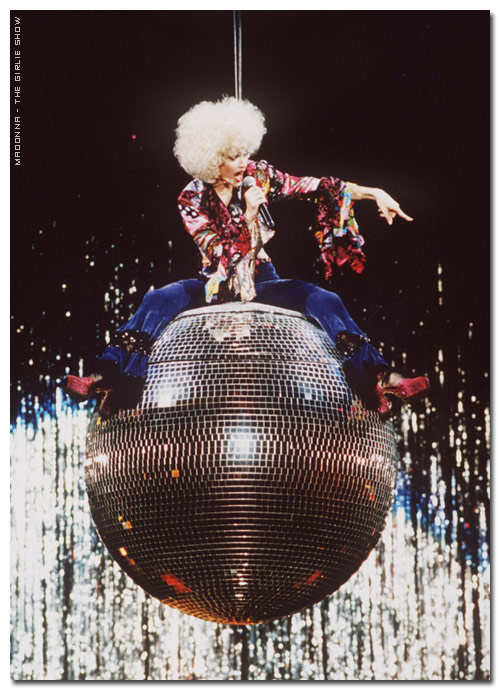
|
MT: Let's step to her next show, one of those memorable
moments in the "Girlie Show" is again the "Express
Yourself" performance that in that tour is performed
in a '70's style with the giant disco ball and the pshichedelic
red and yellow lights...
PM: In rehearsals those of us behind the lighting
and sound boards said: "it doesn't work".
We all thought it was a mistake and she lost her mind (laughs).
We lit it and I understood what she was doing and we didn't
think it would work and of course everybody loved it, that
shows you what I know (laughs).
She again had a great sense for what would work even if
everyone around her thinks she might be wrong or loosing
her mind.
And frankly with Madonna anything works, and that's really
the key to the puzzle, nothing ever fails with her, and
that was a good example of that.
That was an easy one to light because 60's disco, I hate
to admit it but I grew up through that so I understood that
very well.
It was something that I'd never thought I'd have to do but
here I was lighting a mirrorball, several mirrorballs, especially
the big one with her sitting on.
MT: Another great moment
was that part in "Erotica" when Madonna is moving
around the pole surrounded by those beams lighting upwards.
How did this powerful idea come to life?
PM: They were actually
down on the floor, when it was televised and shot for video
they shot right into those beams which was the point of
course those were special lights, they were telescans, that's
a fixture that doesn't exist anymore.
It's a French fixture actually and they are a very strong
light source and at that period of time very few people
were using them and the pattern that we put in was like
a spinning spyral, so to speak, if you look right in it,
right in the eye of the light it feels like a laser tunner,
like you're in tunnel.
I thought it was a great look for what she was doing on
the pole at the beginning. It kept her lit naturally from
over head and little bit from the front from one side or
the other so it had a very mysterious and yet sexy look
to it.
And again that was a very simple moment that just came together
magically.
The key is what I say for "Drowned World", less
is more.
Basically sometimes the magic and the music is not the note
but it's the space between those notes and what I learned
from "Drowned World" is that magic wasn't so much
the lighting we were using but it was where we were not
lighting.
|
|
| |
Copyright
2005 MadonnaTribe
Pictures courtesy of Peter Morse used by permission.
|
|
|
|
|

